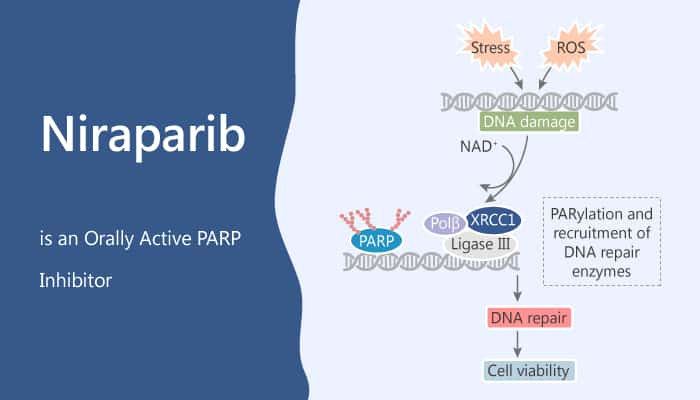Poly (ADP-ribose) polymerases (PARPs) are a family of related enzymes. PARP shares the ability to catalyze the transfer of ADP-ribose to target proteins. PARP plays an important role in various cellular processes, including modulation of chromatin structure, transcription, replication, recombination, and DNA repair. Niraparib (MK-4827) is a potent PARP inhibitor, which radiosensitizes human lung and breast cancer cells. PARP inhibitors may also increase tumor sensitivity to DNA-damaging agents. Moreover, Hyperactivation of the PARP pathway selectively kills cancer cells.
PARP-1 and the closely related PARP-2 are nuclear proteins and possess DNA binding domains. Especially, inhibition of PARP-1 can sensitize tumor cells to classes of DNA damaging drugs. In particular, PARP-1 participates in a range of cellular processes. These processes include regulation of apoptosis, cell division, transcriptional regulation, and differentiation, as well as chromosome stability. Niraparib displays excellent PARP 1 and 2 inhibition with IC50=3.8 and 2.1 nM, respectively, Niraparib inhibits PARP activity with EC50=4 nM in a whole-cell assay. Niraparib inhibits the proliferation of cancer cells with mutant BRCA-1 and BRCA-2 with CC50 in the 10-100 nM range. In MDA-MB-436 human mammary gland adenocarcinoma cells carrying BRCA-1 mutations, Niraparib (MK-4827) displays CC50=18 nM, while in CAPAN-1 human pancreatic adenocarcinoma cells, Niraparib displays CC50=90 nM.
Niraparib is well tolerated in vivo and demonstrates efficacy as a single agent in a xenograft model of BRCA-1 deficient cancer. Niraparib displays good pharmacokinetic properties. Therefore, the PARP pathway and its inhibition offer a number of opportunities for therapeutic intervention in both cancer and other disease states. All in all, Niraparib is a PARP-1/2 inhibitor with strong anti-tumor activity.
